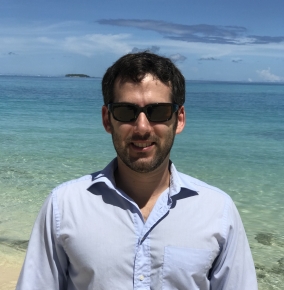Andrew Mack

What’s a typical day at Kwajalein like?
During the work week, I wake up to a full email inbox. I drop the kids at daycare and ride to the terminal for a 15-minute flight to Roi-Namur, the island of radars. I walk through a chicken patch and along the ocean side to the TRADEX (for Tracking and Discrimination Experiment) radar building. With the few hours of work overlap with the main MIT Lincoln Laboratory campus in Massachusetts, I'm in meetings with colleagues all morning. Afterward, I connect with the range contractors to go over designs and technical matters and perform radar measurements if possible (the radars are tightly scheduled with multiple users engaged in satellite tracking, missile testing, and science experiments probing the ionosphere). For the remaining hours, I'm back at my desk, responding to emails, making presentations, reading research articles, and contacting suppliers. I'm also involved in some program management, monitoring budgets and schedules. At the end of the day, I run to the terminal, fly back to Kwajalein, and stop at the grocer before heading home.
On the weekends, I pile my two boys into a bicycle trailer filled with beach toys and ride about a mile to Coral Sands Beach — a beach with shade, a gentle breeze, and soft sand. They play for a few hours, digging holes and chasing hermit crabs. For lunch, we head to the "Chow Hall," or dining hall. After lunch, we ride home for quiet time and playtime during the hot hours. Once it cools off outside, we head to Emon Beach, a short ride away, and enjoy the calmer waters, slide, and company.
What does your work at Roi-Namur focus on?
I work as part of a team upgrading the backends of the four radars on Roi-Namur. The term "radar" conjures images of big dishes moving around and pointing at targets. Behind the dishes are radio-frequency and signal processing electronics — that's the backend hardware we're upgrading.
The most exciting part of my work is being able to test components on real radars. Lincoln Laboratory often develops concepts and performs demonstrations, but Kwajalein has operational systems, and making changes to operational systems is challenging.
How did you become interested in STEM and radars?
My mother taught me the programming language BASIC when I was nine years old, at the same time she taught it as a graduate student. I was probably too young to learn it, but how a computer parses commands stuck with me, and the head start always made me feel like I was good at something. Growing up, my best friend and I were interested in HAM radio and played with antennas and the old Radio Shack build-your-own radio kits. I always liked electromagnetics in undergrad, where I studied physics and worked in a physics lab researching quantum states that arise at low temperatures. In graduate school, I built machines that pulled DNA with tightly focused lasers to measure the physics of DNA packaging. Both experiences involved designing experiments, programming, machining, building electronics — and making a lot of mistakes. My engineering judgment in telling how long something will take and how likely it is to succeed dramatically improved through multiple experiences of building experiments from scratch.